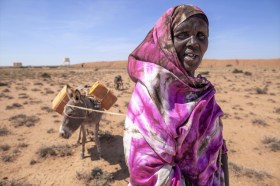
For sub-Saharan populations (here, a woman in Somaliland), prolonged droughts are among the most dramatic consequences of global warming. Keystone / Mark Naftalin / United Nations D
The industrialised countries are the main producers of CO2 emissions. However, they are not doing enough to help poorer nations – worst hit by the effects of global warming – to cope with the climate crisis. A new report criticises the laxity of European countries, Switzerland among them.
The industrialised countries are the main producers of CO2 emissions. However, they are not doing enough to help poorer nations – worst hit by the effects of global warming – to cope with the climate crisis. A new report criticises the laxity of European countries, Switzerland among them.
This content was published on February 12, 2021 -
Luigi Jorio Pauline Turuban
For Benjamin Vargas it is a question of “life or death”. When we met him in 2018 on his land in Tiquipaya, Bolivia, the farmer explained in clear terms why sustainable management of water is so important, as climate change makes this precious resource becomes increasingly scarce. Thanks to an artificial lake dug out on the mountainside, Vargas and other farmers in the area can collect rainwater and irrigate their fields during the dry season.
The project was funded by Swiss development aid and is an example of the support provided by the Alpine nation to communities most vulnerable to climate change. But despite the obvious benefit of the reservoir for Bolivian farmers, the climate action undertaken by Switzerland and other industrialised countries to help the poorest regions of the planet is still far from the commitment External link made more than ten years ago.
For Benjamin Vargas it is a question of “life or death”. When we met him in 2018 on his land in Tiquipaya, Bolivia, the farmer explained in clear terms why sustainable management of water is so important, as climate change makes this precious resource becomes increasingly scarce. Thanks to an artificial lake dug out on the mountainside, Vargas and other farmers in the area can collect rainwater and irrigate their fields during the dry season.
The project was funded by Swiss development aid and is an example of the support provided by the Alpine nation to communities most vulnerable to climate change. But despite the obvious benefit of the reservoir for Bolivian farmers, the climate action undertaken by Switzerland and other industrialised countries to help the poorest regions of the planet is still far from the commitment External link made more than ten years ago.
The polluter pays
During the UN climate conference in Copenhagen in 2009, the industrialised nations agreed to allocate $100 billion (CHF90 billion) a yearExternal link by 2020 to help developing countries limit greenhouse gas emissions and adapt to climate change.
It was a signal of solidarity, but above all of responsibility – a principle also enshrined in the Paris Climate Agreement. The richest nations, responsible for most emissions, have a duty to support those states that are the least to blame for global warming, but which are suffering the greatest impact.
According to the latest surveyExternal link by the Organization for Economic Co-operation and Development (OECD), in 2018 developing countries received $78.9 billion in climate finance, of which $62.2 billion came from public funds and $14.6 billion from the private sector (the remainder were export credits). This represented an 11% increase over 2017.
Half a billion dollars from Switzerland
Switzerland, for its part, contributed $554 million in 2018. The Federal Office for the Environment explained that, in calculating the country’s share, the government took account of its economic capacity and consequent emissions.
Of this total, $340 million came from public funds, drawn mainly from the international development budget. Private investments ($214 million) were made mainly through multilateral development banks. By way of comparison, Switzerland’s international climate funding corresponds to about one-tenth of its public spending on national security.
External Content
Where does the climate money go?
Asia was the main beneficiary of climate funding in 2018 (43%), followed by Africa (25%) and the Americas (17%). The countries that received the most aid from Switzerland were Bolivia, Peru and Indonesia.
Some 70% of the climate funding distributed in 2018 was dedicated to mitigating climate change – for example, building renewable energy production plants. Meanwhile, projects to help countries adapt to climate change received only 20% of the funding (the remaining 10% went to cross-cutting projects).
Various NGOs have denounced this imbalance, arguing that financial flows should be redirected towards helping the most vulnerable countries adjust to the consequences of global warming. One need only think of the small island States, where urgent measures are necessary to protect against rising sea levels.
However, this is not the only criticism levelled at the climate funding mechanism.

Rising sea levels threaten the existence of the Pacific island of Tuvalu. Usage Worldwide
‘Fair share’ from Switzerland and Europe
In 2019, climate funds from the EU and its member countries totaled $27 billion, according to a reportExternal link issued in mid-January by ACT Alliance EU, a network of humanitarian agencies linked to the Christian Church. However, Europe’s “fair share” should amount to $33-36 billion, the group said.
Considering its climate footprint abroad, Switzerland should also increase its contribution to $1 billion, according to Jürg Staudenmann of Alliance Sud, a coalition of six large Swiss international development organisations. However, doing so at the expense of the fight against poverty, by drawing funds from the development cooperation budget, is “cynical” and harmful, Staudenmann said in a statement.
No link with climate action
Many NGOs, including Britain’s Oxfam, also argue that the real value of climate finance is overestimated, and that it is actually only one thirdExternal link of that reported by the industrialised countries. There are basically two reasons for this discrepancy.
Firstly, there are inaccuracies (exaggerations) in the way the climate component of a given project is calculated. For instance, when a building with photovoltaic panels is put up, the cost of the entire construction is reported and not just that of the solar installation.
A recent report External link by Care International identifies Japan as one of the main ‘offenders’, as it counted projects – worth over $1.3 billion – that had nothing to do with the climate. These included the building of a bridge and a motorway in Vietnam. Three Swiss-funded projects, too, had no identifiable link with climate change, Alliance Sud noted on the basis of a German study.
Secondly, only 20% of the funding is provided in the form of direct aid. Industrialised countries are increasingly resorting to loans – which must be repaid sooner or later, sometimes with interest rates comparable to commercial ones – and other financial instruments, in a practice denounced by OxfamExternal link. Switzerland is one of the few donors – together with the EU, Australia, the Netherlands and Sweden – that allocates funds almost exclusively in the form of grants.
Which country is the most generous?
If we take into account direct aid only – that is, excluding loans – and national wealth, we can draw what ACT Alliance EU considers to be a true picture of European countries’ commitment to helping the poorest nations cope with climate change.
By this calculation, Sweden is the most generous State, and one of the only ones – along with Germany and Norway – to allocate more than 0.1% of gross national income to climate finance. Switzerland is in ninth position with 0.048%.
No comments:
Post a Comment